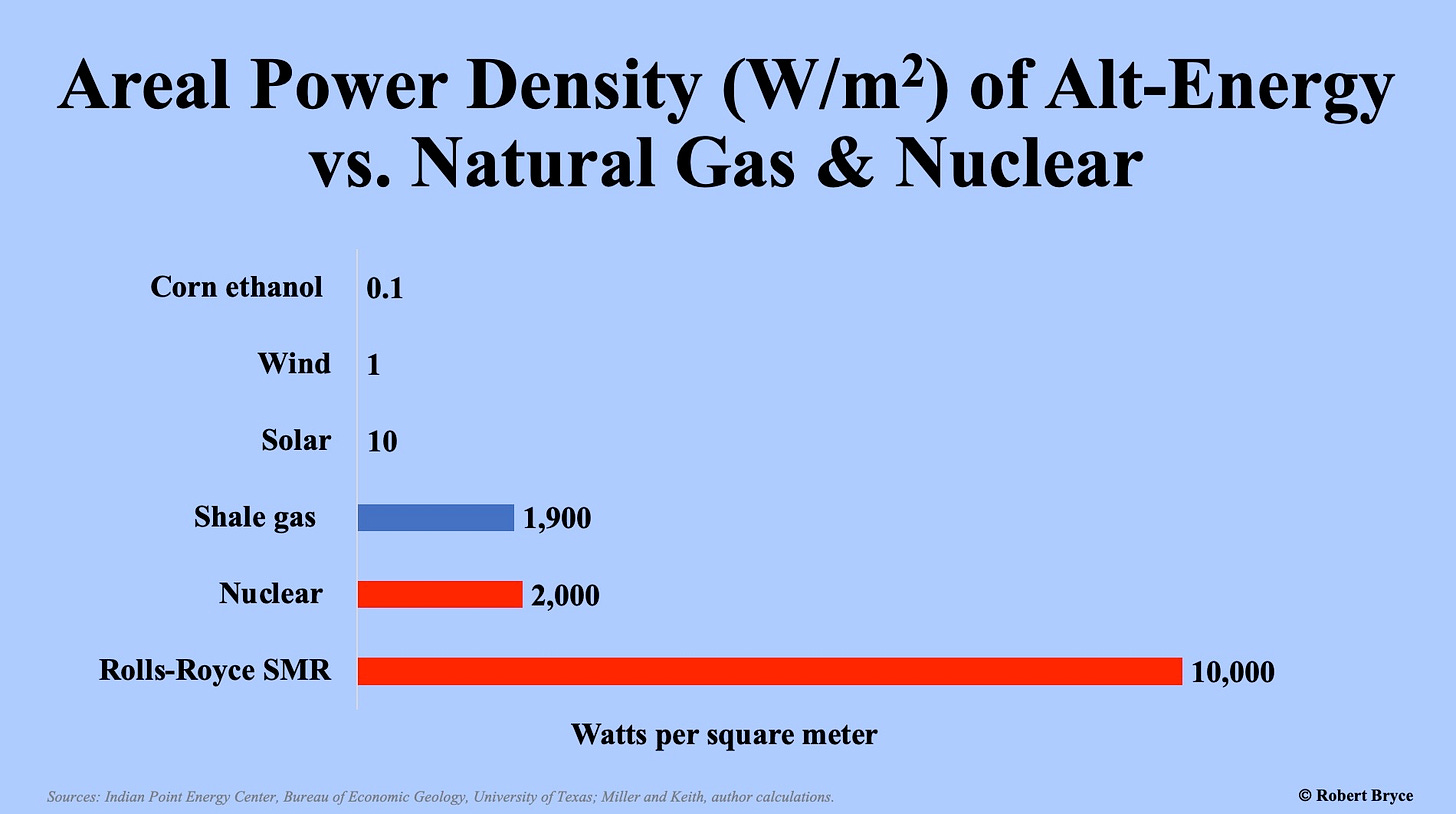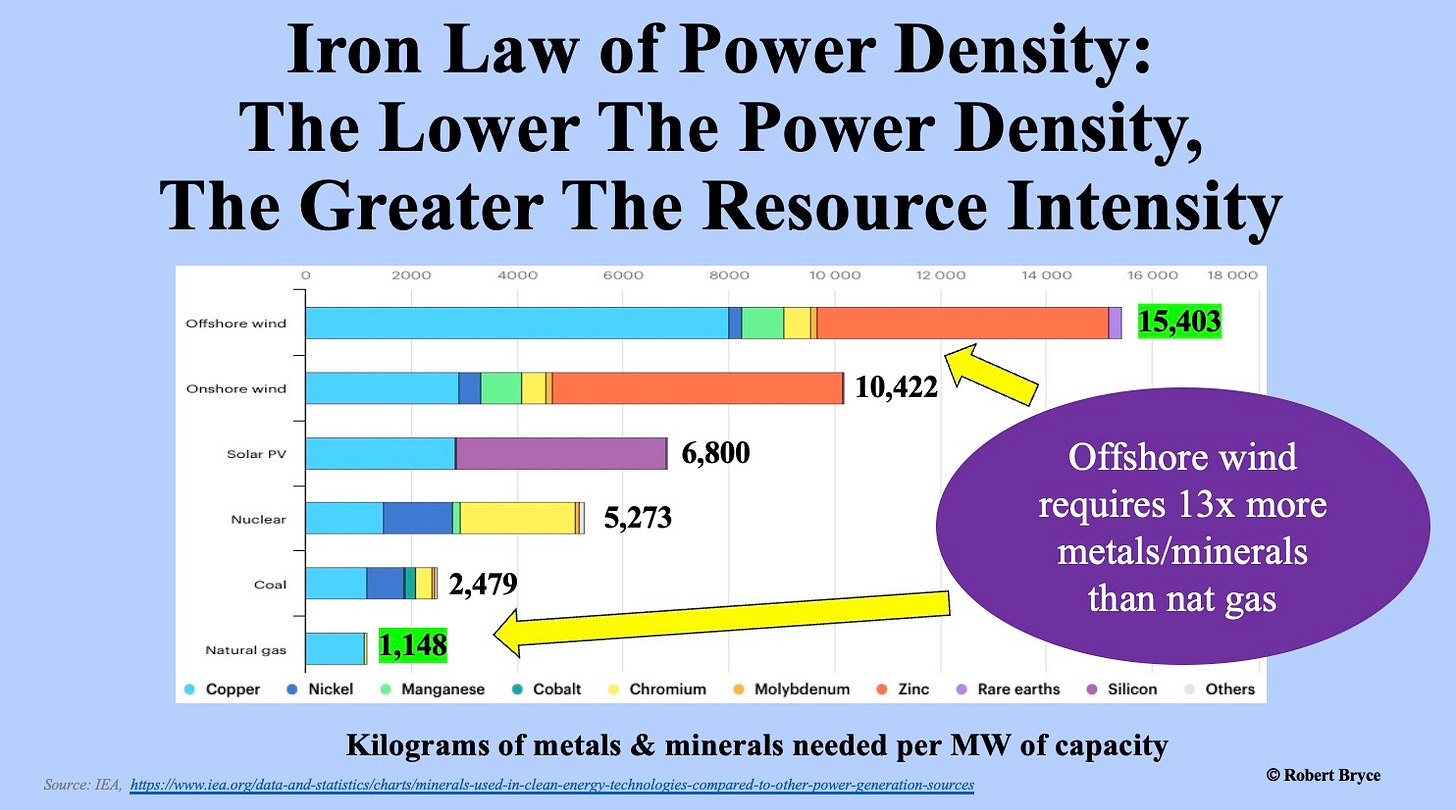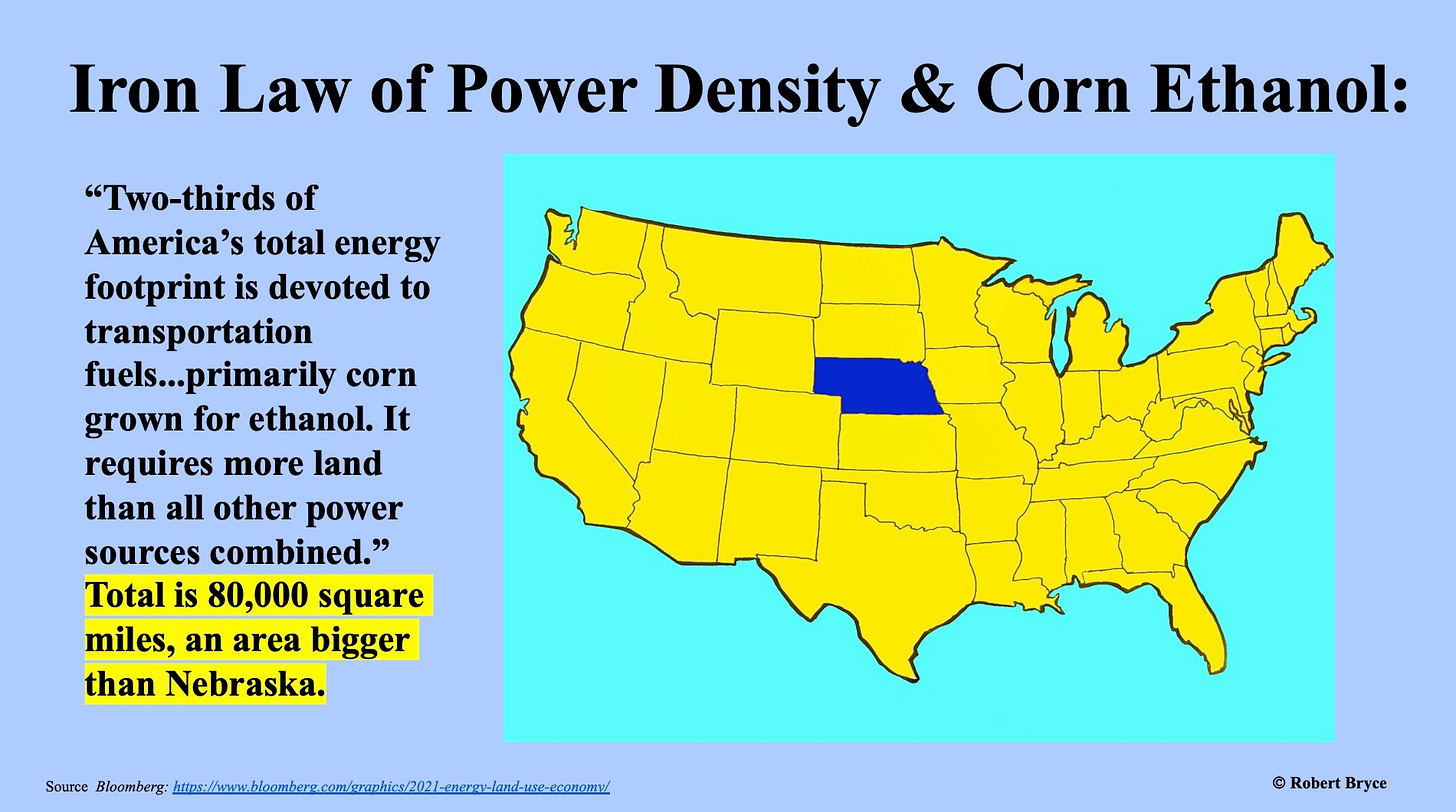The Power Of Power Density
Paul Krugman hypes renewables in the New York Times, but the Iron Law of Power Density won’t be repealed

In an August 7 article, New York Times columnist Paul Krugman claimed that “technological progress in renewable energy has made it possible to envisage major reductions in emissions at little or no cost in terms of economic growth and living standards.”
He continued, writing that last year’s Inflation Reduction Act “consisted almost entirely of carrots — tax credits and subsidies for green energy. Yet thanks to the revolution in renewable technology, energy experts believe that this all-gain-no-pain approach will have major effects in reducing greenhouse gas emissions.”
That last line included a link to an analysis done by academics at Princeton University. They claim that massive deployments of wind and solar energy — deployments that would require covering state-sized tracts of land with wind turbines and solar panels and doubling or tripling the size of our high-voltage transmission system — could result in significant cuts in emissions. Krugman went on to claim that “the climate war is now part of the culture war” and that “right-wingers” are “rejecting the science in part because they dislike science in general.” All of this, he avers, is part of a years-long conspiracy to prevent action on climate that’s being led by “fossil-fueled think tanks.”
Before going further, it must be noted that in his piece, “Climate Is Now A Culture War Issue,” Krugman failed to mention the disgraceful role that two richly funded climate NGOs played in increasing New York’s reliance on fossil fuels. Not a word about former New York governor Andrew Cuomo and how he and his co-conspirators at Riverkeeper and Natural Resources Defense Council forced the premature closure of the nuclear reactors at the Indian Point Energy Center in 2021, a move that resulted in increased generation from natural gas-fired power plants and a huge jump in the state’s greenhouse gas emissions. (It must also be noted that presidential hopeful Robert F. Kennedy Jr. was a key player in Riverkeeper’s push to shutter Indian Point.) Nor did Krugman mention that Riverkeeper and Natural Resources Defense Council callously cheered the closure of the plant in the pages of the New York Times.
But I digress.
None of the claims in Krugman’s August 7 column are new. For years, academics from elite universities, climate activists, leaders of the anti-industry industry, and legacy media outlets (and the New York Times in particular) have been peddling shopworn claims about “all-gain-no-pain” renewables.
You’ve no doubt heard them: renewables are cheap and getting cheaper, wind and solar energy are the future, and the main reason that conservatives and knuckle-dragging rural landowners are opposing massive renewable projects all across America is that they don’t understand “science.”
That’s the spin. Here’s the reality: the conspiracy against wind and solar is one of basic math and simple physics. It’s not conservatives who are wrong on “science,” it’s liberals like Krugman and his myriad allies in the climate claque who refuse to recognize (or even discuss) the physical limits on our energy and power networks.
The shape and size of our energy systems are not being determined by political beliefs about climate change. Instead, those systems are ruled by the Iron Law of Power Density which says: the lower the power density, the greater the resource intensity. This can easily be seen in the graphic above. It includes a screen grab from a 2021 International Energy Agency report on the mineral intensity of various methods of electricity generation. The mineral intensity of offshore wind, including huge amounts of copper and zinc, is shocking: roughly 15,400 kilograms per megawatt of generation capacity. That is roughly 13 times more than the amount needed for natural gas-fired generation (1,148 kg) and six times more than what’s needed for a coal plant (2,479 kg).
The Iron Law of Power Density explains why Siemens Energy just reported a $2.4 billion loss on its wind business in the latest quarter. It explains why offshore wind projects here in the U.S. and in Europe, are being canceled left and right. It also explains why, all around the world, rural communities and landowners are fighting back against the landscape-blighting encroachment of massive wind and solar projects.
But I’m getting ahead of myself.
Power density is perhaps the most important, and least understood, metric in physics. Power density is the essential metric for understanding our energy and power systems. Indeed, the global history of energy over the last 250 years, from the steam engines designed by Newcomen and Watt to the latest nuclear reactor designs and computer chips, can be grasped by seeing them through the lens of power density. So what is power density?
Before going further, a quick primer: energy and power are commonly confused, even by people who work in the energy sector. Remember: energy and power are not the same thing. Energy (measured in joules, or Btu) is the ability to do work. Power (measured in watts, or horsepower) is the rate at which work gets done. As I have said many times, we don’t care about energy. What we want is power. That is, we don’t care what form of energy (oil, sun, coal, or gas) that’s being used to power our car, run our television, or cook our quinoa, we only care that we have the power needed to do the work at hand. Put another way, energy is useless if we can’t make it flow. And the more we can make energy flow, the more power we can produce and therefore, the more work we can do.
Writer and polymath Vaclav Smil calls power density the “key analytical variable to evaluate all important biospheric and anthropogenic energy flows.” So, again, what is it?
Power density is the measure of energy flow that can be harnessed from a given area, volume, or mass. Power density is a measure of how many watts we can get per square meter, liter, or kilogram from a given source. This article focuses on areal power density. Proving why low-power-density sources are the wrong choice for modern society takes only a modicum of effort.
Let’s start by looking at corn ethanol and other biofuels, which have a power density of about 0.1 watt per square meter. Counteracting that paltry power density requires lots of other resources, including fertilizer, diesel fuel, water, and staggering amounts of land. In 2021, Dave Merrill, a reporter and data analyst at Bloomberg, reported that “Two-thirds of America’s total energy footprint is devoted to transportation fuels produced from agricultural crops, primarily corn grown for ethanol. It requires more land than all other power sources combined.” Merrill determined that biofuels require the cultivation of about 80,000 square miles of cropland. As can be seen in the graphic above, that’s an area bigger than the state of Nebraska.
Corn ethanol, wind, and solar are not only dependent on the weather, they are also cursed with low power density. (About 1 watt per square meter for wind and 10 watts per square meter for solar.) That means that like ethanol, they, too, require vast amounts of land. They also require vast amounts of copper, zinc, molybdenum, silicon, and rare earth elements like neodymium. With inflation hitting commodities of all kinds, the mineral intensity of wind and solar is hitting the bottom lines of the big renewable companies.

Indeed, late last year, Siemens Energy, which produces wind turbines, announced a big drop in its expected profits. During a TV appearance, the CEO of Siemens Energy, Christian Bruch, confirmed the Iron Law of Power Density. Bruch said:
“Never forget, renewables like wind roughly, roughly, need 10 times the material [compared to]... what conventional technologies need...So if you have problems on the supply chain, it hits … wind extremely hard, and this is what we see.” Bruch also said there is “still a way to go” in the maturation of the wind industry and that there are problems with distributing “risk along the supply chain in a world which is much more volatile, much more difficult, much more multilateral than before.” He continued, saying “if we don’t resolve it as an industry...we’ll fail with the energy transition.”
If your power plant requires 10 times more material inputs than other forms of power generation, it’s readily apparent why Siemens and other companies in the wind business are getting blown away. Last year, GE’s renewable business lost $2.2 billion. That loss was blamed on “inflation and supply chain pressures.” The company has cut its onshore wind turbine workforce by 20% and according to Reuters, the last time GE’s renewable business made a profit was in 2020.
Since Bruch’s TV appearance, the problems at Siemens Energy have worsened. Last week, the German company announced it lost $2.4 billion on its wind business in the latest quarter and it expects to lose $4.9 billion in 2023 due to costly fixes it will have to make to wind turbines it has sold. What happened? In the ongoing effort to wring more electricity from the diffused energy in wind, Siemens has made bigger and bigger machines with longer and longer blades. In doing so, they made the turbines more fragile and thus more likely to break. On August 7, the same day Krugman’s column was published in the Times, Reuters reported that in addition to the multi-billion-dollar loss the company:
also cut its sales outlook, and issued a new, lower profit outlook after withdrawing it in the wake of the disclosed issues, which include wrinkles in rotor blades and faulty gears at its newer onshore turbines. The equipment and service provider to the power industry said only some of the 2,900 turbines of its most recent 4.X and 5.X models in the field were affected by the problems, but declined to provide a specific number.
The same issues are happening in the offshore wind sector. Over the past few weeks, several projects have been cancelled. Spanish utility Iberdrola agreed to pay fines to cancel a contract for an offshore project in Massachusetts, and Danish company Orsted had its offshore project in Rhode Island scuttled due to soaring costs. Meanwhile, an offshore project in Britain was canceled by Sweden’s Vattenfall.
As Howard Rhodes of EnergyPortal.eu explained earlier this month, the offshore sector is facing “a financial crisis as costs continue to rise. Inflation in components and labor costs, along with rising interest rates, has led to a 57% increase in the costs associated with U.S. offshore wind projects since 2021.” Soaring commodity prices have also increased the cost of making onshore wind turbines. By one estimate, the cost of building a wind turbine has surged by 38% over the past two years.
The other key facet of the Iron Law of Power Density, of course, is land use. The only way to substantially increase the production of wind and solar energy is by seizing more and more land, (or ocean) so they can be covered with more and more steel, concrete, copper, and silicon. As I reported in these pages on August 4, in “Massive Riots, Renewable Resentments,” the backlash against the encroachment of large wind and solar projects is real, it’s global, and it’s growing. As can be seen in the Renewable Rejection Database, the total number of rejections and restrictions on wind and solar in the U.S. now totals 575.
Krugman didn’t bother to mention land use in his article. That’s not surprising. The New York Times has steadfastly refused to cover the land-use conflicts in New York even though it is arguably the epicenter of the backlash against large-scale renewables. The Renewable Rejection Database contains 66 rejections or restrictions of renewables in New York since 2015. Indeed, the backlash in the state has been so stout that the potentates in Albany passed a measure known as Article 94c, that gives state officials the authority to override local zoning laws and force communities to accept renewable projects they don’t want.
Of course, these facts don’t fit the narrative that Krugman and others are pushing. So they go unreported and unmentioned in the pages of the Times. Krugman ended his piece by saying the incentives available to corporate interests and communities are giving them “a stake in continuing the green transition.” But, he said those incentives “won’t do much to persuade people who believe that green energy is a conspiracy against the American way of life.”
Krugman’s right. There is a conspiracy afoot. It’s called the Iron Law of Power Density.
It will not be repealed.
Note: This piece has been corrected and updated since it was published. Siemens lost $2.4 billion on its wind business in the latest quarter, not for the year. Further, the company expects to lose $4.9 billion in 2023 on its renewables business. Thanks to Jonathan Lesser for catching the error. I also updated the Iron Law of Power Density graphic by adding the call-out bubble.
As always, please click that ♡ button.
Please subscribe and share.




I worked in the power industry for over 15 years after graduating college. I’ve been directly and remotely involved with virtually every form of production and transmission. I was on a team coordinating a lot of these discussions with EPRI. And I can attest to the difficulty people seem to have understanding the difference between energy and “capacity”, or “power” as used above.
Another aspect is that of timely delivery. Wind and solar, for example, only produce when environmental conditions are right. People today need energy all the time. Without storage, such as very large batteries (or lots of small ones) these methods are insufficient. I don’t know if this reality was included in the power density numbers above, but if not, it only adds to the problem.
Thank you for the very enlightening article!
I guess winning a Nobel Prize let’s one spout off on all sorts of nonsense that is unrelated to their chosen area of study. Krugman is just one example, but he is probably one of the worst...